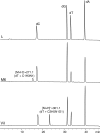Identification and biosynthesis of thymidine hypermodifications in the genomic DNA of widespread bacterial viruses
- PMID: 29555775
- PMCID: PMC5889632
- DOI: 10.1073/pnas.1714812115
Identification and biosynthesis of thymidine hypermodifications in the genomic DNA of widespread bacterial viruses
Abstract
Certain viruses of bacteria (bacteriophages) enzymatically hypermodify their DNA to protect their genetic material from host restriction endonuclease-mediated cleavage. Historically, it has been known that virion DNAs from the Delftia phage ΦW-14 and the Bacillus phage SP10 contain the hypermodified pyrimidines α-putrescinylthymidine and α-glutamylthymidine, respectively. These bases derive from the modification of 5-hydroxymethyl-2'-deoxyuridine (5-hmdU) in newly replicated phage DNA via a pyrophosphorylated intermediate. Like ΦW-14 and SP10, the Pseudomonas phage M6 and the Salmonella phage ViI encode kinase homologs predicted to phosphorylate 5-hmdU DNA but have uncharacterized nucleotide content [Iyer et al. (2013) Nucleic Acids Res 41:7635-7655]. We report here the discovery and characterization of two bases, 5-(2-aminoethoxy)methyluridine (5-NeOmdU) and 5-(2-aminoethyl)uridine (5-NedU), in the virion DNA of ViI and M6 phages, respectively. Furthermore, we show that recombinant expression of five gene products encoded by phage ViI is sufficient to reconstitute the formation of 5-NeOmdU in vitro. These findings point to an unexplored diversity of DNA modifications and the underlying biochemistry of their formation.
Keywords: DNA modification; bacteriophage; hypermodification; pyrimidine.
Copyright © 2018 the Author(s). Published by PNAS.
Conflict of interest statement
The authors declare no conflict of interest.
Figures







Similar articles
-
Type II Restriction of Bacteriophage DNA With 5hmdU-Derived Base Modifications.Front Microbiol. 2019 Mar 29;10:584. doi: 10.3389/fmicb.2019.00584. eCollection 2019. Front Microbiol. 2019. PMID: 30984133 Free PMC article.
-
Pathways of thymidine hypermodification.Nucleic Acids Res. 2022 Apr 8;50(6):3001-3017. doi: 10.1093/nar/gkab781. Nucleic Acids Res. 2022. PMID: 34522950 Free PMC article.
-
Polymer-level synthesis of oxopyrimidine deoxynucleotides by Bacillus subtilis phage SP10: characterization of modification-defective mutants.J Virol. 1985 Feb;53(2):522-7. doi: 10.1128/JVI.53.2.522-527.1985. J Virol. 1985. PMID: 3918174 Free PMC article.
-
Biosynthesis and Function of Modified Bases in Bacteria and Their Viruses.Chem Rev. 2016 Oct 26;116(20):12655-12687. doi: 10.1021/acs.chemrev.6b00114. Epub 2016 Jun 20. Chem Rev. 2016. PMID: 27319741 Review.
-
Viruses versus bacteria-novel approaches to phage therapy as a tool against multidrug-resistant pathogens.J Antimicrob Chemother. 2014 Sep;69(9):2326-36. doi: 10.1093/jac/dku173. Epub 2014 May 28. J Antimicrob Chemother. 2014. PMID: 24872344 Review.
Cited by
-
Identification of the minimal bacterial 2'-deoxy-7-amido-7-deazaguanine synthesis machinery.Mol Microbiol. 2018 Nov;110(3):469-483. doi: 10.1111/mmi.14113. Epub 2018 Oct 12. Mol Microbiol. 2018. PMID: 30159947 Free PMC article.
-
Type II Restriction of Bacteriophage DNA With 5hmdU-Derived Base Modifications.Front Microbiol. 2019 Mar 29;10:584. doi: 10.3389/fmicb.2019.00584. eCollection 2019. Front Microbiol. 2019. PMID: 30984133 Free PMC article.
-
Crystal structure of the modification-dependent SRA-HNH endonuclease TagI.Nucleic Acids Res. 2018 Nov 2;46(19):10489-10503. doi: 10.1093/nar/gky781. Nucleic Acids Res. 2018. PMID: 30202937 Free PMC article.
-
Genomes from Uncultivated Pelagiphages Reveal Multiple Phylogenetic Clades Exhibiting Extensive Auxiliary Metabolic Genes and Cross-Family Multigene Transfers.mSystems. 2022 Oct 26;7(5):e0152221. doi: 10.1128/msystems.01522-21. Epub 2022 Aug 16. mSystems. 2022. PMID: 35972150 Free PMC article.
-
TET methylcytosine oxidases: new insights from a decade of research.J Biosci. 2020;45:21. J Biosci. 2020. PMID: 31965999 Free PMC article. Review.
References
-
- Weigele P, Raleigh EA. Biosynthesis and function of modified bases in bacteria and their viruses. Chem Rev. 2016;116:12655–12687. - PubMed
-
- Kirnos MD, Khudyakov IY, Alexandrushkina NI, Vanyushin BF. 2-aminoadenine is an adenine substituting for a base in S-2L cyanophage DNA. Nature. 1977;270:369–370. - PubMed
-
- Ehrlich M, Ehrlich KC. A novel, highly modified, bacteriophage DNA in which thymine is partly replaced by a phosphoglucuronate moiety covalently bound to 5-(4′,5′-dihydroxypentyl)uracil. J Biol Chem. 1981;256:9966–9972. - PubMed
Publication types
MeSH terms
Substances
LinkOut - more resources
Full Text Sources
Other Literature Sources
Medical
Molecular Biology Databases

